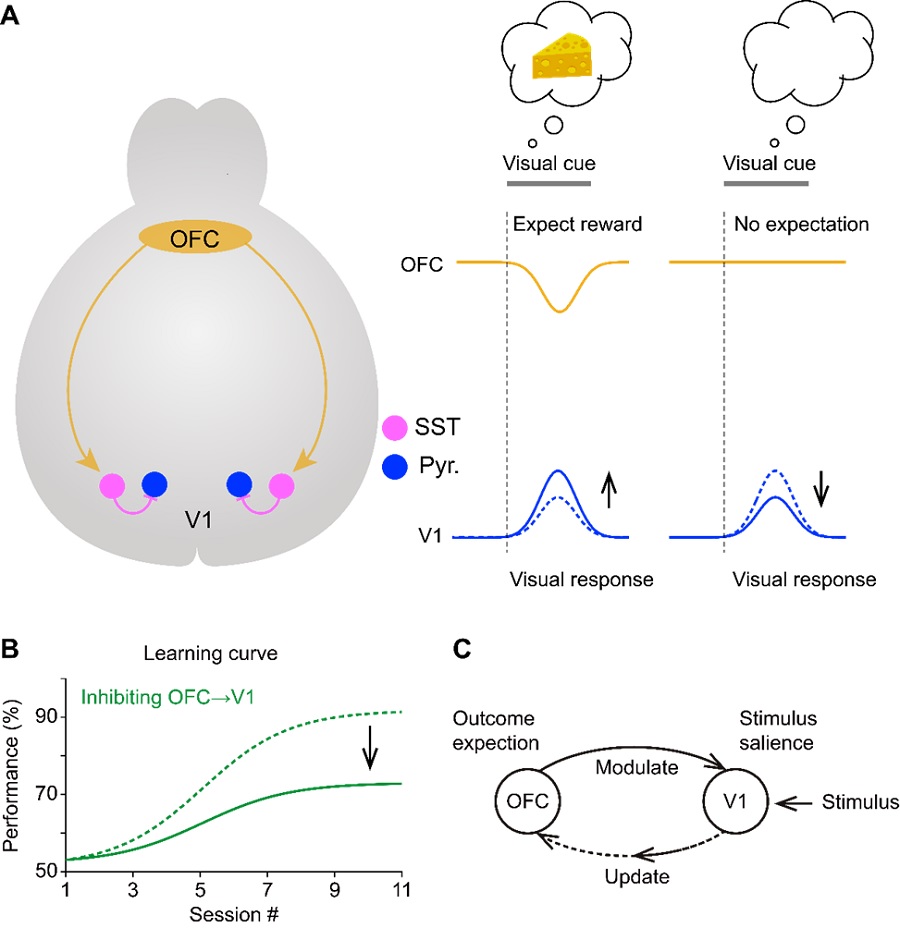Time:2020-06-03
A recent study published in Nature Communications reveals that the top-down projection from orbitofrontal cortex to primary visual cortex contributes to visual associative learning. This work was performed by researchers in Dr. YAO Haishan’s Lab at the Institute of Neuroscience, Center for Excellence in Brain Science and Intelligence Technology of Chinese Academy of Sciences, State Key Laboratory of Neuroscience.
The orbitofrontal cortex (OFC) plays an important role in flexible, outcome-guided behavior. Studies in rodents and monkeys have demonstrated that the identity and expected values of specific outcomes are represented by activities in the OFC. Lesions or inactivation of the OFC impair behavior guided by outcome expectancy and learning driven by the discrepancy between expected and actual outcomes. Direct output from the OFC to other brain regions, including the basolateral amygdala, ventral tegmental area and striatum, is important for learning and reward-related behavior. The OFC also projects to sensory cortices, including primary visual cortex (V1), yet the function of this top-down projection is unclear.
The authors examined how OFC top-down projection influences V1 neuronal responses. They found that activating OFC axons in V1 significantly reduced the firing rates of V1 neurons in both anesthetized and awake mice. Using slice recording and in vivo fiber photometry recording, they found that activating OFC top-down projection preferentially activated somatostatin (SST) interneurons in V1. The authors hypothesized that OFC projection to V1 may function during task engagement to suppress V1 responses to non-relevant visual stimulus. They trained mice to perform a Go/No-Go visual task, in which the Go stimulus and the No-Go stimulus were associated with water reward and no reward, respectively.
They found that learning of the task depended on the improvement of correct rejection for the reward-irrelevant No-Go stimulus. In mice performing a Go/No-Go visual task, V1 responses to the reward-irrelevant No-Go stimulus were lower when the mice’ outcome expectation was correct than when it was incorrect, and such response modulation was reduced by optogenetic inactivation of OFC projection to V1. Using optogenetic tagging technique, the authors found that the V1-projecting OFC neurons reduced firing during expectation of reward. They further showed that chronic optogenetic inactivation of OFC projection to V1 slowed the learning of Go/No-Go visual task, and chronic activation of SST interneurons in V1 improved the learning.
In summary, Dr. YAO’s lab demonstrates that the OFC projection to V1 plays a key role in filtering out non-relevant visual information to facilitate associative learning.
This work entitled “Orbitofrontal control of visual cortex gain promotes visual associative learning” was published online in Nature Communications on June 3, 2020. This work was completed by LIU Dechen, under the supervision of Dr. YAO Haishan, with help from Dr. DENG Juan, ZHANG Zhewei and ZHANG Zhi-Yu, and with strong support from Dr. SUN Yang-Gang and Dr. YANG Tianming. This work was supported by grants from National Natural Science Foundation of China, Chinese Academy of Sciences, and Shanghai Municipal Government.

Orbitofrontal projection to V1 contributes to visual associative learning.
Figure legend: A. During stimulus-reward association, OFC top-down projection to V1 mediates the outcome-expectancy modulation of V1 responses to visual stimuli. B. Inactivating OFC projection to V1 impairs visual associative learning. C. The response modulation in V1 represents a change in stimulus salience, which may in turn contribute to the update of outcome expectation signal in the OFC, potentially contributing to change of performance in future trials. (Image by CEBSIT)
YAO Haishan , Ph.D.
Email:haishanyao@ion.ac.cn
 附件下载:
附件下载: